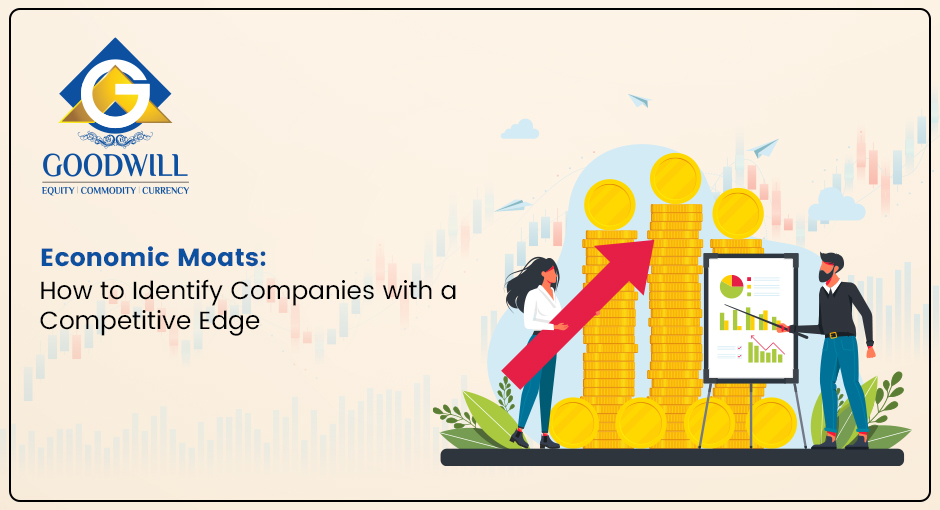
Economic Moats: How to Identify Companies with a Competitive Edge
Economic moats are a metaphorical concept that describes a company’s competitive advantage in the marketplace. The term was coined by Warren Buffet. It describes a business’s capacity to hold onto its market share and profitability over an extended period, despite competition. Economic moats are crucial. Because they can help investors identify companies with sustainable competitive advantages over their peers. This can lead to higher returns on investment over the long term.
Thank you for reading this post, don't forget to subscribe!Economic moats can be created through various means such as, patents, trademarks, brand recognition, economies of scale, and network effects. In the stock market, companies with strong economic moats are often valued higher than their peers. Because they are seen as having a more sustainable competitive advantage.
There are different types of economic moats. For example, Competitive Advantage, Wide Economic Moat, Cost Advantage Moat, Intangible Assets Moat, High Switching Costs Moat, Size Advantage Moat, and Soft Moats.
Competitive Advantage is a type of economic moat that refers to a company’s ability to produce goods or services more efficiently than its competitors. This can be achieved through economies of scale, proprietary technology, or other factors that give the company an edge over its peers.
Wide Economic Moat is a type of economic moat that refers to a company’s ability to maintain its competitive advantage over an extended period. This can be achieved through brand recognition, patents, or other factors. These factors make it difficult for competitors to replicate the company’s success.
Cost Advantage Moat is a type of economic moat that refers to a company’s ability to produce goods or services at a lower cost than its competitors. This can be achieved through economies of scale, proprietary technology, or other factors that give the company an edge over its peers.
Intangible Assets Moat is a type of economic moat that refers to a company’s ability to maintain its competitive advantage through intangible assets. For example, patents, trademarks, and brand recognition.
High Switching Costs Moat is a type of economic moat that refers to a company’s ability to maintain its competitive advantage by making it difficult for customers to switch to another product or service. This can be achieved through proprietary technology or other factors that make it difficult for customers to switch.
Size Advantage Moat is a type of economic moat that refers to a company’s ability to maintain its competitive advantage through economies of scale. This can be achieved through increased production volume or other factors that give the company an edge over its peers.
Soft Moats are intangible factors such as corporate culture and management style that can contribute to a company’s competitive advantage.
Some examples of economic moats include brand recognition, patents, and economies of scale. Companies with strong economic moats are more likely to achieve long-term success and provide better returns for investors. Investors can use various tools such as fundamental analysis and technical analysis, to identify companies with strong economic moats. Fundamental analysis involves analyzing a company’s financial statements and business model to determine its intrinsic value, while technical analysis involves analyzing a company’s stock price and trading volume to identify trends and patterns.
Equity derivatives are financial instruments that derive their value from an underlying stock or index. Commodity derivatives derive their value from an underlying commodity such as gold, silver, or crude oil. Investors can use equity derivatives and commodity derivatives to invest in companies with strong economic moats. For example, an investor can use a call option to buy a stock at a predetermined price. If the stock price increases, the investor can exercise the option and buy the stock at a lesser price.
Simply, an investor can use a commodity futures contract to buy a commodity such as gold at a predetermined price. If the price of gold rises, the investor can sell the futures contract and make a profit. However, investing in derivatives can be risky and requires a thorough understanding of the underlying asset and market conditions.
Investors can also use mutual funds to invest in companies with strong economic moats by choosing funds that focus on quality stocks with sustainable competitive advantages. Some of the best mutual funds to invest in 2023 India include Axis Bluechip Fund, Mirae Asset Large Cap Fund, and SBI Bluechip Fund.
These funds have a track record of investing in quality stocks with strong economic moats and have delivered consistent returns over the long term. However, investors should conduct thorough research and analysis before investing in any mutual fund. They should also consider their risk tolerance and investment goals before making investment decisions.
Conclusion
Goodwill is one of the top equity brokers in India that offers a range of services including online trading platforms, research reports, and investment advice. By leveraging Goodwill’s resources, investors can make informed decisions and identify companies with strong economic moats. Investors can analyze the financial statements and business models of these companies to identify their economic moats. Additionally, our technical analysis tools can be used to identify trends and patterns in the stock price and trading volume.
However, before making any investment selections, investors should do an in-depth investigation and analysis. You should also consider the risk tolerance and investment goals before investing in any stocks. Goodwill provides the necessary training and support for successful investing. Happy investing!

